Kalamata and Castelvetrano Olive Sourdough
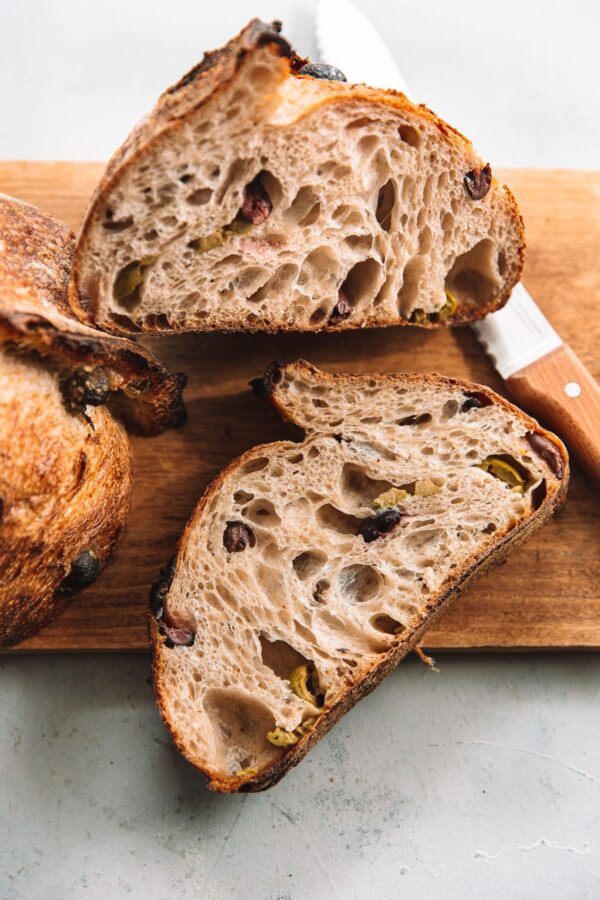
OLIVE SOURDOUGH INGREDIENTS:
- 300 grams unbleached bread flour
- 140 grams 90% extraction wheat or whole wheat flour
- 360 grams 90°F/32°C filtered water, divided
- 90 grams ripe sourdough starter (100% hydration)
- 9 grams kosher salt or fine sea salt
- 75 grams pitted Castelvetrano olives, sliced in half
- 75 grams pitted Kalamata olives, sliced in half
- white rice flour, for dusting
Baker’s Percentages:
Use the following baker’s percentages to tweak and adapt this sourdough bread recipe to suit your own flour, hydration, or yield preferences. Please know the timeline might change. I recommend sticking to the same salt and sourdough starter percentages.
- Bread Flour: 68%
- Whole Wheat Flour: 32%
- Water: ~82% (*this is a rough hydration percentage – true hydration takes into account the flour and water in your starter)
- Sourdough Starter: 20%
- Salt: 2%
- Olives: 34%
RECIPE NOTE: This sourdough bread recipe offers a rough timeline, but will need to be adapted to meet your specific conditions. Ambient temperature, starter strength, and flour type (as well as other variables) affect fermentation and play a very important role in bread baking.
How to Make Olive Sourdough Bread:
STEP 1: PREPARE THE AUTOLYSE
In a large mixing bowl, combine 300 grams unbleached bread flour and 140 grams 90% extraction wheat or whole wheat flour.
Add 350 grams (90°F/32°C) filtered water and mix, using a Danish dough whisk or your hands, until thoroughly combined and no dry bits are visible. Cover with a clean shower cap or plastic wrap, and rest at 78°F/25.5°C for 1 hour and 30 minutes. This step hydrates the flours and helps build dough structure.
I use my Brod & Taylor Proofing Box to maintain a relatively high ambient fermentation temperature. It is an amazing tool, but not required. However, I recommend finding a warmer spot in your kitchen (was 74°F-76°F) for resting your dough. Cooler ambient temperatures will slow down fermentation and might extend bulk fermentation time significantly.
*Planning Tip: Since this recipe doesn’t call for preparing an off-shoot levain, I mix and prepare the autolyse roughly an hour and a half before my normal morning starter feeding time.
STEP 2: ADD RIPE STARTER AND REST FOR 30 MIN
Add the remaining 10 grams filtered water and 90 grams ripe, just peaked sourdough starter. Use your fingertips to spread the starter over the autolyse mixture. Fold the edges of the dough into the center to fully incorporate the starter.
Use your thumb and fingers to pinch the dough (pincer method) repeatedly until the starter and remaining water is well incorporated. Don’t be delicate. You want to work quickly, but fully incorporate the mixture. Cover once again and rest at 78°F/25.5°C for 30 minutes.
STEP 3: ADD SALT AND REST FOR 15 MIN
Sprinkle 9 grams Diamond Crystal kosher or fine sea salt over the surface of the dough. Use your thumb and fingers to pinch and incorporate the salt into the dough (you should not feel any granules at the end of mixing). Be thorough. Depending on the coarseness of the salt, this mixing step usually takes about 3 to 5 minutes.
If you’re struggling with higher hydration doughs and dough strength, there are two additional mixing methods that can try: slap and fold or the Rubaud method. Please watch my artisan sourdough video for visual demonstration.
Cover and rest at 78°F/25.5°C for 15 minutes before preforming the first stretch and fold set.
STEP 4: BULK FERMENTATION
We’ll preform three stretch and fold sets during the first 45 minutes of bulk fermentation. Each set will take place in 15-minute intervals. Cover and rest the dough at 78°F/25.5°C between each set.
To complete a stretch and fold, dip you hands lightly in water (*this will help the dough from sticking). Grab the top portion of the dough with both hands. Gently pull and stretch it upwards (without tearing) and fold over the opposite edge. Rotate the bowl 180° degrees and repeat from the other side.
Rotate the bowl 90° degrees and repeat once again on both sides. This entire process is one stretch and fold set. For a visual demonstration, please see this video.
STEP 5: LAMINATION (ADDING THE OLIVES)
After preforming the third and final stretch and fold set, cover and allow the dough to rest at 78°F/25.5°C for 30 minutes. Spritz your workspace with water (this will prevent the dough from sticking) – simply dip your hands in water and wipe the countertop lightly (or you can use a mister).
Gently transfer and turn the dough out onto your workspace.
Using both of your hands, gently grab and stretch the dough into a thin, large rectangular shape. The dough should be well developed and strong, and should be able to be stretch into a thin layer without tearing.
Distribute the pitted and halved olive mixture across the surface of the dough.
At this point, we’ll fold the dough into an envelope. To do so, fold the dough by grabbing both the top and bottom edge of the left or right side, and gently folding it over until it reaches the center. Repeat from the other side, folding it over so that it overlaps the previous fold.
Grab the top edges and fold them down, and repeat from the bottom edge.
Flip the dough so that it is seam side down, and using your hands, gently and quickly shape it into a loose round. Transfer the dough back to the bowl, cover, and rest at 78°F/25.5°C.
STEP 6: BULK FERMENTATION (CONTINUED)
After lamination, allow the dough to rest for roughly 45 minutes before proceeding. After 45 minutes, we’ll preform two coil folds (with a 30-minute rest period between each).
To preform a coil fold, lift the dough from the center using both hands, allowing both ends to stretch and release from the container, and then fold under. Rotate the bowl 90° degrees and repeat. Cover and rest the dough at 78°F/25.5°C between coil folds.
Note: If the dough is very rounded in the bowl, feels very strong and is fighting you, you can skip these folds and simply allow the dough to rest for the remainder of bulk fermentation.
After you have preformed the stretch and folds, allow the dough to rest, covered, at 78°F/25.5°C for an additional 1.5 – 2 hours, or until the dough feels lively, has a few surface bubbles, is rounded on the edges, jiggles slightly in the bowl, and has nearly doubled in size.
STEP 7: PRE-SHAPE
Carefully transfer the dough, without degassing, onto a clean countertop. Use a bench knife to gently shape the dough into a round, pulling it towards you on the countertop to create some surface tension. The key is to do this step as quickly and gently as possible.
Rest the dough, uncovered, for 15 to 20 minutes, or until it has relaxed for the final shaping.
STEP 8: FINAL SHAPE
Dust the lined banneton basket lightly with rice flour. Lightly dust the surface of the dough with bread flour. Use a bench knife to gently lift it and flip it flour side-down onto your countertop.
Shape into a batard (oval) (see video) or shape into a round depending on your basket and baking vessel.
Gently pick up the shaped dough, flip, and transfer into your floured banneton, with the seam side facing up. Drape a linen over the basket (to capture any condensation) and cover the banneton with a plastic bag.
STEP 9: FINAL PROOF
Place covered banneton in the refrigerator and retard dough for 15 to 16 hours at 38°F/3°C. This slow and cold fermentation stage helps develop flavor and improves the final crust texture.
STEP 10: PREHEAT THE OVEN AND PAN
Preheat your Challenger Pan, Dutch Oven, or combo cooker (with lid) in a 500°F/260°C oven for at least 1 hour.
STEP 11: BAKE
Once the oven and baking vessel have preheated for an hour, remove the banneton from the refrigerator and uncover. Transfer the dough to the baking vessel – see recipe for more detailed instructions – and score the loaf with a bread lame. Please see recipe video for visual instruction.
Bake at 500°F/260°C with the lid on for 25 minutes. Remove the lid, reduce the oven temperature to 475°F/240°C (*note: if your oven runs hot or your loaves are browning too quickly, reduce the temperature to 450°F/232°C) and continue to bake uncovered for an additional 15-25 minutes or until the crust is deep golden and caramelized. I like to rotate the pan several times throughout baking to ensure even color.
Transfer to a cooling rack and cool completely before slicing. This will take several hours. Enjoy!
How to Serve Olive Sourdough:
- this olive sourdough is fantastic with a high-quality extra virgin olive oil for dipping (Lucini’s Premium Select is a wonderful option available in most grocery stores; Biancolilla is another personal favorite)
- pair with my favorite hearty red lentil soup
- use as a base for Italian sandwiches or tuna sandwiches (Nicoise-style!)
- brush thick slices with olive oil and lightly grill on both sides, serve with your favorite dips and spreads
Troubleshooting Issues and FAQ:
If you’re experiencing troubleshooting issues with this recipe or other sourdough baking, please check out my Sourdough Bread Troubleshooting Guide or leave a comment below.
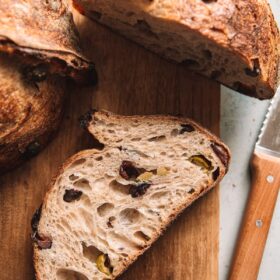
Kalamata and Castelvetrano Olive Sourdough
Ingredients
- 300 grams unbleached bread flour plus more for dusting
- 140 grams 90% extraction wheat flour or whole wheat flour
- 360 grams 90°F/32°C filtered water divided
- 90 grams ripe sourdough starter 100% hydration
- 9 grams Diamond Crystal kosher or fine sea salt
- 75 grams pitted Castelvetrano olives sliced in half
- 75 grams pitted Kalamata olives sliced in half
- white rice flour for dusting your banneton basket
Instructions
- Please read through the blog post for additional notes and step-by-step photos before proceeding. You can also find an example baking timeline below the instructions.
- IMPORTANT NOTE: Many sourdough bread recipes call for preparing an off-shoot levain (eg. starter) for baking. I prefer to scale up and use a portion of my ripe, just peaked starter. This eliminates one extra step and works better for my normal feeding schedule and preferred baking timeline. This choice is up to you and can be tweaked/adapted to fit your schedule or starter feeding schedule, but please plan accordingly. Keep in mind that you'll need to account for the starter quantity in this recipe (90 grams), as well as the normal quantity needed to continue to maintain and feed your starter.
- Autolyse: In a large mixing bowl, combine 300 grams unbleached bread flour and 140 grams 90% extraction wheat or whole wheat flour. Add 350 grams (90°F/32°C) filtered water and mix with your hands until thoroughly combined and no dry bits are visible. Cover with a clean shower cap or plastic wrap, and rest at 78°F/25.5°C for 1 hour and 30 minutes. This step hydrates the flours and helps build dough structure.
- Add Starter and Rest: Add the remaining 10 grams filtered water and 90 grams ripe, just peaked sourdough starter. Use your fingertips to spread the starter over the autolyse mixture. Fold the edges of the dough into the center to fully incorporate the starter. Use your thumb and fingers to pinch the dough (pincer method) repeatedly until the starter is well incorporated. Don’t be delicate. You want to work quickly, but fully incorporate the mixture. Cover and rest at 78°F/25.5°C for 30 minutes.
- Add Salt and Rest: Sprinkle 9 grams Diamond Crystal kosher or fine sea salt over the surface of the dough. Use your thumb and fingers to pinch and incorporate the salt thoroughly (you shouldn't feel any granules at the end of mixing) into the dough. Depending on the coarseness of your salt, this might take several minutes. Be thorough. Cover and rest at 78°F/25.5°C for 15 minutes. Important Note and Tip: If you’re struggling with higher hydration doughs and dough strength, there are two additional mixing methods that can try: slap and fold or the Rubaud method. Please watch my YouTube video for further instruction.
- Bulk Fermentation: We will preform 3 sets of stretch and folds in the first 45 minutes of bulk fermentation. These will take place in 15-minute intervals. Cover and rest the dough at 78°F/25.5°C between each set. The dough will not visibly rise during the stretch and fold period, but it should get considerably stronger. Dip your hands in water (to prevent sticking) before each fold. I like to rub my hands together to avoid incorporating much more water, as this is already a high hydration dough. How to Preform a Stretch and Fold: Grab the top portion of the dough with both hands. Gently pull and stretch it upwards (without tearing) and fold over the opposite edge. Rotate the bowl 180 degrees and repeat from the other side. Rotate the bowl 90 degree and repeat once again on both sides. This entire process is one stretch and fold set. After performing the stretch and folds, I like to gently lift the dough to round it nicely in the bowl (see video). *
- Lamination (Adding the Olives): After preforming the third and final stretch and fold set, cover and allow the dough to rest at 78°F/25.5°C for 30 minutes. Lightly spritz your workspace with water (this will prevent the dough from sticking) – simply dip your hands in water and wipe the countertop lightly. Gently transfer and turn the dough out onto your workspace. Using both of your hands, gently grab and stretch the dough into a thin, large rectangular shape. The dough should be well developed and strong, and should be able to be stretch into a thin layer without tearing. Distribute the pitted and halved olive mixture across the surface of the dough.
- At this point, we’ll fold the dough into an envelope. To do so, fold the dough by grabbing both the top and bottom edge of the left or right side, and gently folding it over until it reaches the center. Repeat from the other side, folding it over so that it overlaps the previous fold. Grab the top edges and fold them down, and repeat from the bottom edge. Flip the dough so that it is seam side down, and using your hands, gently and quickly shape it into a loose round. Transfer the dough back to the bowl, cover, and rest at 78°F/25.5°C. Note: Lamination helps add incredible strength to high-hydration loaves (with inclusions) and ensures equal distribution of add-in ingredients.
- Bulk Fermentation (continued): After lamination, allow the dough to rest for roughly 45 minutes before proceeding. After 45 minutes, we’ll preform two coil folds (with a 30-minute rest period between each). How to Preform a Coil Fold: Lift the dough from the center using both hands, allowing both ends to stretch and release from the container, and then fold under. Rotate the bowl 90° degrees and repeat. Cover and rest the dough at 78°F/25.5°C between coil folds. After you have preformed the stretch and folds, allow the dough to rest, covered, at 78°F/25.5°C for an additional 1.5 – 2 hours, or until the dough feels lively, has a few surface bubbles, is rounded on the edges, jiggles slightly in the bowl, and has nearly doubled in size. Note: If the dough is very rounded in the bowl, feels very strong and is fighting you, you can skip these folds and simply allow the dough to rest for the remainder of bulk fermentation.
- Pre-Shape: Carefully transfer the dough, without degassing, onto a clean countertop. Use a bench knife to gently shape the dough into a round, pulling it towards you on the countertop to create some surface tension. The key is to do this step as quickly and gently as possible. Rest the dough, uncovered, for 15 to 20 minutes, or until it has relaxed for the final shaping.
- Final Shape: Dust a lined 10 or 11-inch oval banneton basket (or 9-inch round) with white rice flour (be extra liberal if you are not using a cloth or linen liner). Dust the surface of the dough lightly with bread flour. Use a bench knife to gently lift and flip it flour side down onto your countertop. Depending on your preference, banneton, or baking vessel, shape the dough into a round or batard. *Tip: Please watch my YouTube video for visuals on how to shape a batard (oval loaf) or my latest video on how to shape rounds (boules) and bake in a Dutch oven. After shaping, gently pick up the shaped dough, flip, and transfer into your floured banneton, with the seam side facing up. Drape a kitchen linen over the banneton and place the banneton in a plastic bag (*I use a clean plastic produce bag). Seal with a clip.
- Final Proof: Place the covered banneton basket in the refrigerator and retard dough for 15-16 hours at 38°F/3°C. This slow and cold fermentation stage helps develop flavor and improves the final crust texture.
- Preheat the Oven: Preheat your Challenger Pan, Dutch Oven, or combo cooker (with lid on) in a 500°F/260°C oven for at least 1 hour.
- Transfer and Bake: If you are using a Challenger Pan or combo cooker, you can skip parchment (*I like to sprinkle a little semolina on the pan) and carefully invert the basket directly into the preheated base before scoring. If you are using a traditional Dutch oven, please watch this video for visuals: Place a large piece of parchment over the banneton, then top with a thin cutting board. Invert and flip carefully, so that the banneton is upside down, setting it down onto your countertop. The dough should release, right side up, from the banneton onto the parchment. Trim any excess parchment paper, creating two handles on both ends for lifting the dough. Use a bread lame to score the dough (1/2-inch deep), carefully transfer into the preheated pan, cover tightly with the lid, and place in the oven. Bake covered at 500°F/260°C for 25 minutes.
- Remove the lid. The dough should have risen and expanded considerably, and the crust should be set, but only lightly golden in color.
- Reduce the oven temperature to 475°F/240°C (*note: if your oven runs hot or your loaves are browning too quickly, reduce the temperature to 450°F/232°C) and continue to bake uncovered for an additional 15-25 minutes or longer until the crust is deep golden and caramelized. I like to rotate the pan several times during this final stage to ensure even browning.
- Carefully remove the bread from the pan and transfer to a cooling rack. Cool completely before slicing. This will take several hours. Slicing into warm bread will result in a gummier texture and cause the bread to stale faster. For more tips, read my guide on How to Store, Freeze, and Refresh Bread.
Example Baking Timeline:
- DAY ONE:
- 8:00 AM - autolyse (mix flours and 350 grams water). allow mixture to rest, covered, at 78°F/25.5°C for 1 hour and 30 minutes.
- 9:30 AM - add remaining 10 grams water and sourdough starter, mix thoroughly. cover and rest at 78°F/25.5°C for 30 minutes.
- 10:00 AM - add salt and mix thoroughly. cover and rest at 78°F/25.5°C for 15 minutes.
- 10:15 AM - 10:45 AM - stretch and folds #1, #2, #3 (every 15 minutes). cover and rest at 78°F/25.5°C between each set.
- 11:15 AM - laminate the dough, layering in the olive mixture. cover and rest at 78°F/25.5°C.
- 12:00 PM -1:00 PM - preform two coil folds, 30 minutes apart, cover and rest the dough at 78°F/25.5°C between each set.
- 1:00 PM - 2:30 PM - allow to rest, covered, at 78°F/25.5°C for the rest of the bulk fermentation period. this period will range anywhere from 1.5 to 2 (or significantly longer), depending on ambient temperature, starter strength, and flour variety. follow the dough's lead!
- 2:30 PM - pre-shape. leave uncovered at room temperature for 15 - 20 minutes.
- 2:45 PM - final shape. transfer to rice floured banneton basket, cover with a plastic bag, seal, and transfer to the refrigerator.
- 2:45 PM - 7:45 AM - retard dough (final proof) in refrigerator at 38°F/3°C for 15-18 hours.
- DAY TWO:
- 5:45 AM - preheat challenger pan, Dutch Oven, or combo cooker in 500F oven for at least 1 hour.
- 6:45 AM - remove banneton from fridge, transfer dough to preheated pan, score, and bake at 500°F/260°C, covered, for 25 minutes.
- 7:10 AM - remove pan lid, reduce oven temperature to 475°F/240°C, and bake uncovered for an additional 15 to 20 minutes or until deeply caramelized. allow loaf to cool completely (this will take several hours) before slicing.

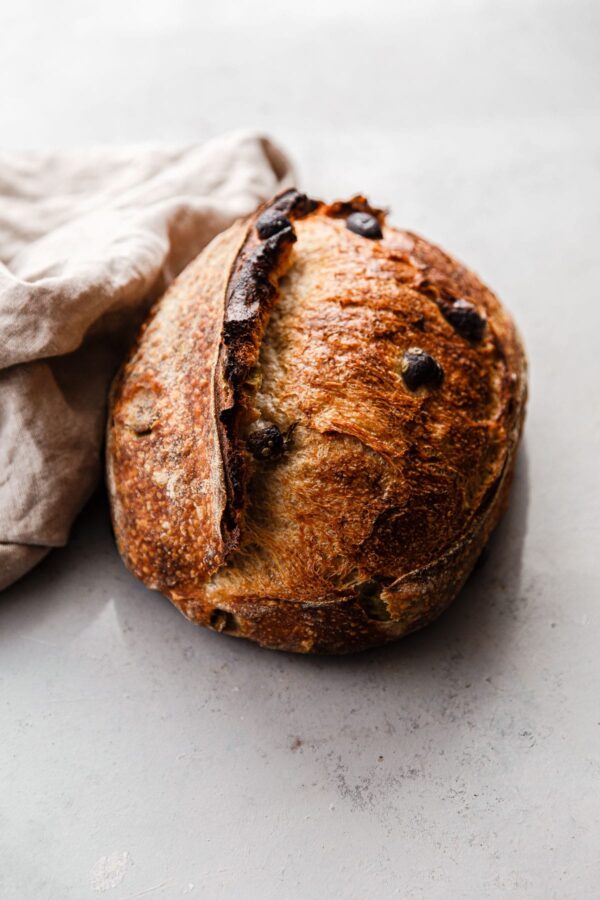
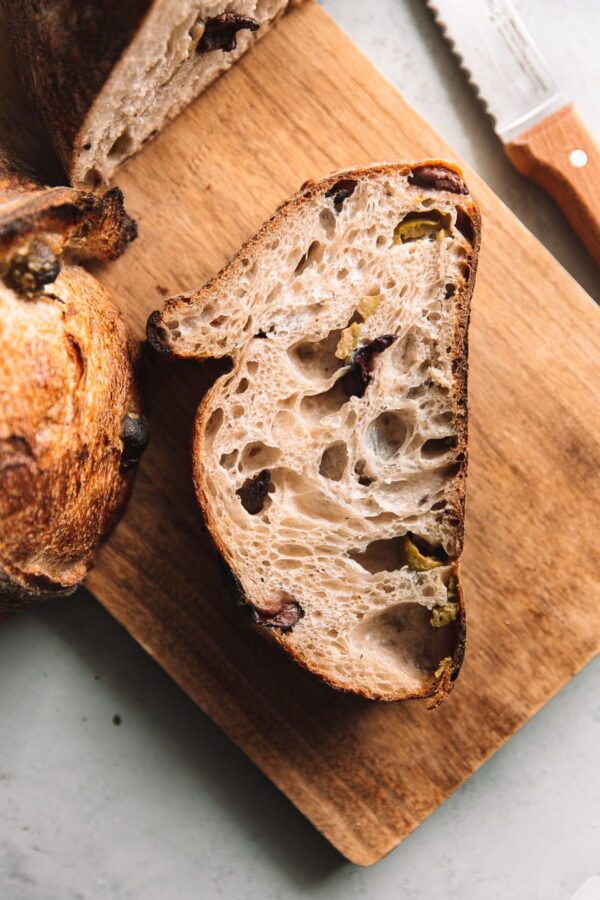
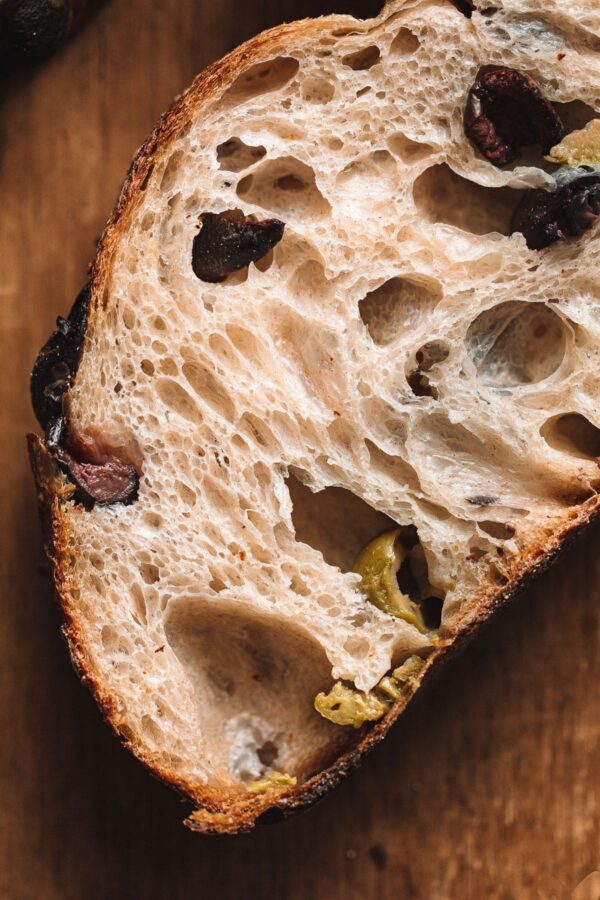
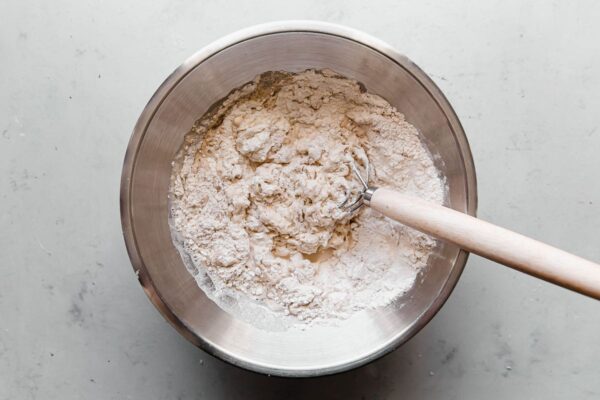
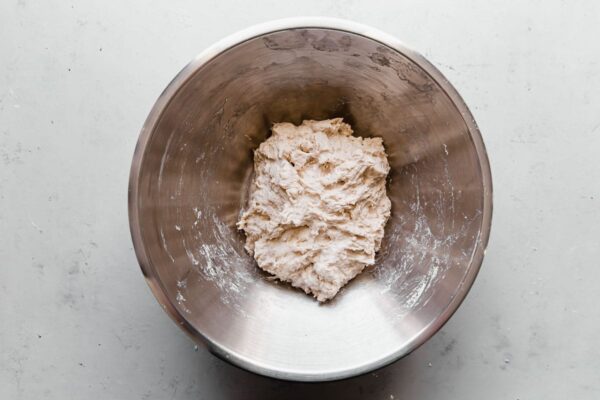
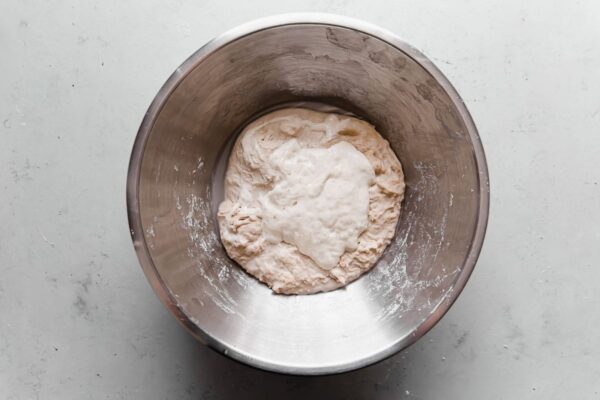
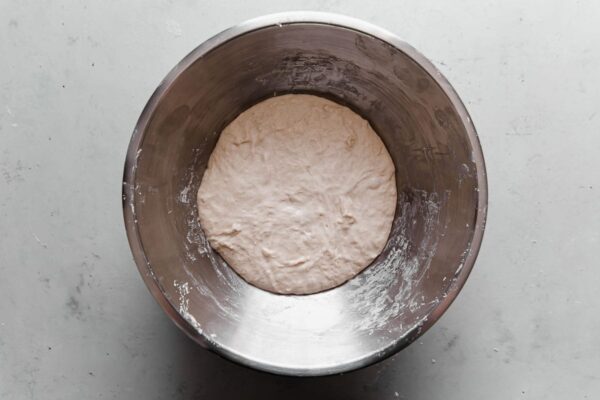
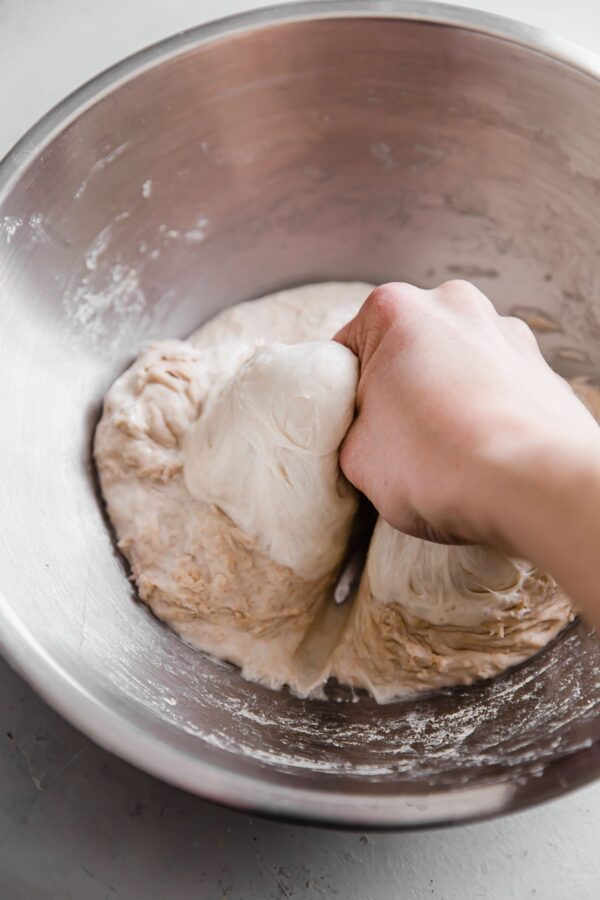
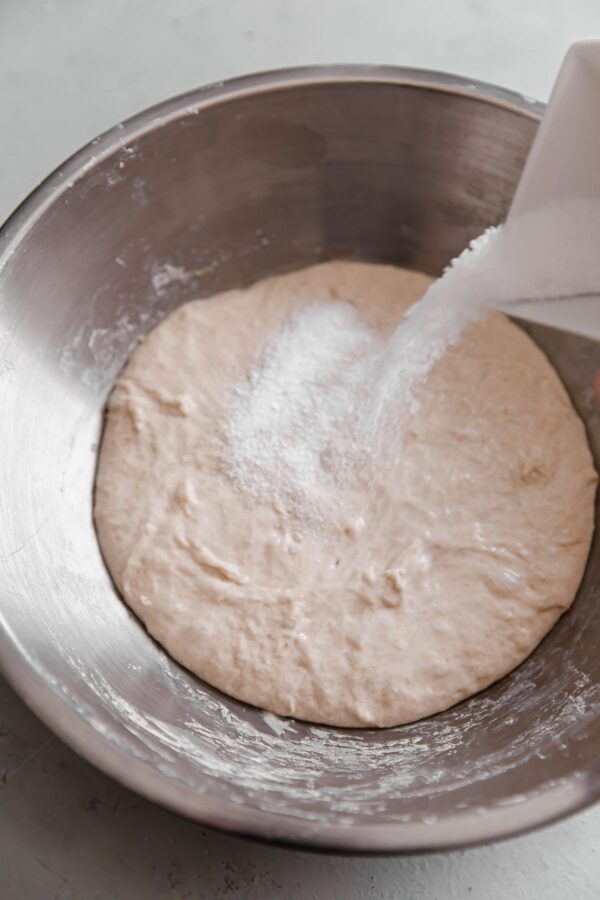
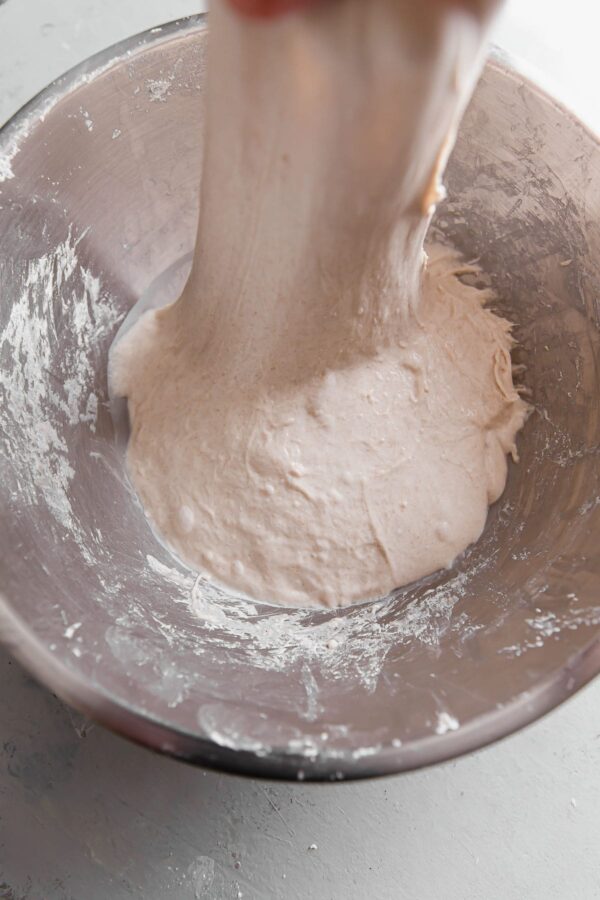
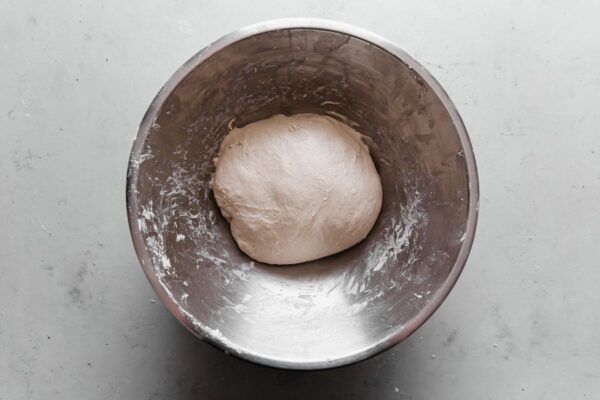
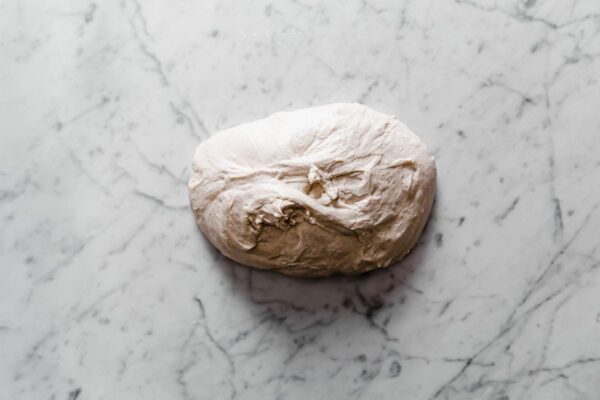
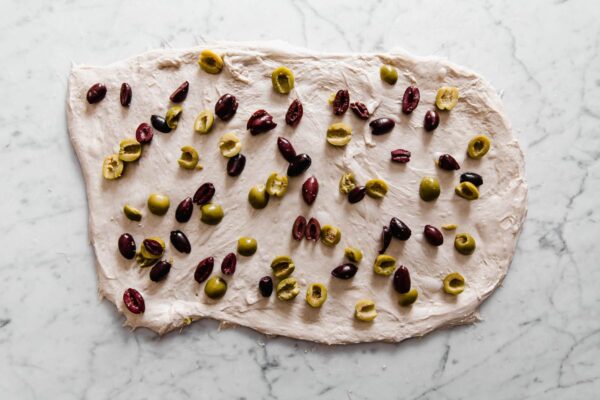
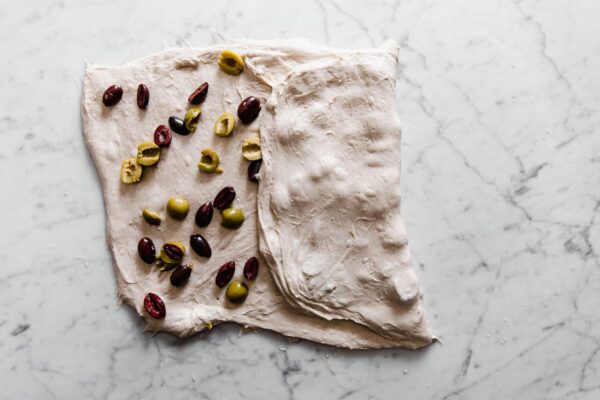
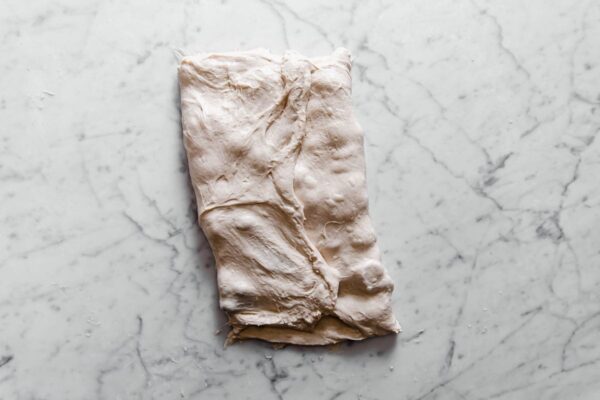
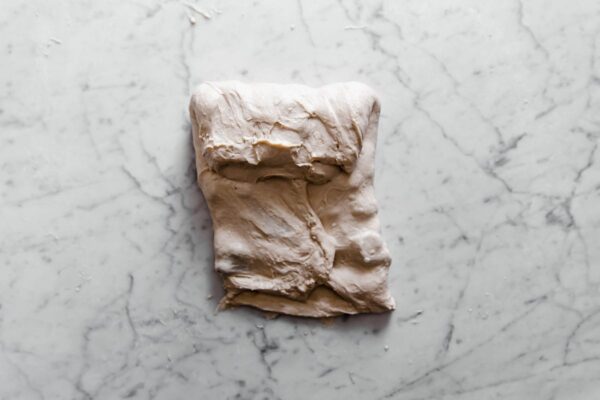
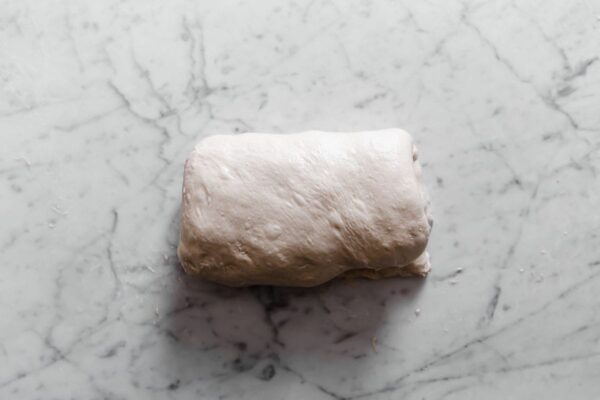
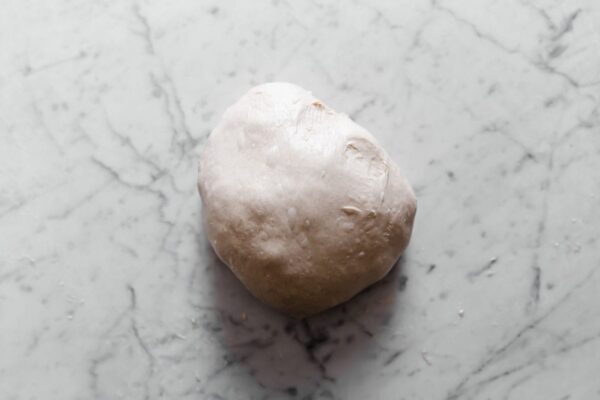
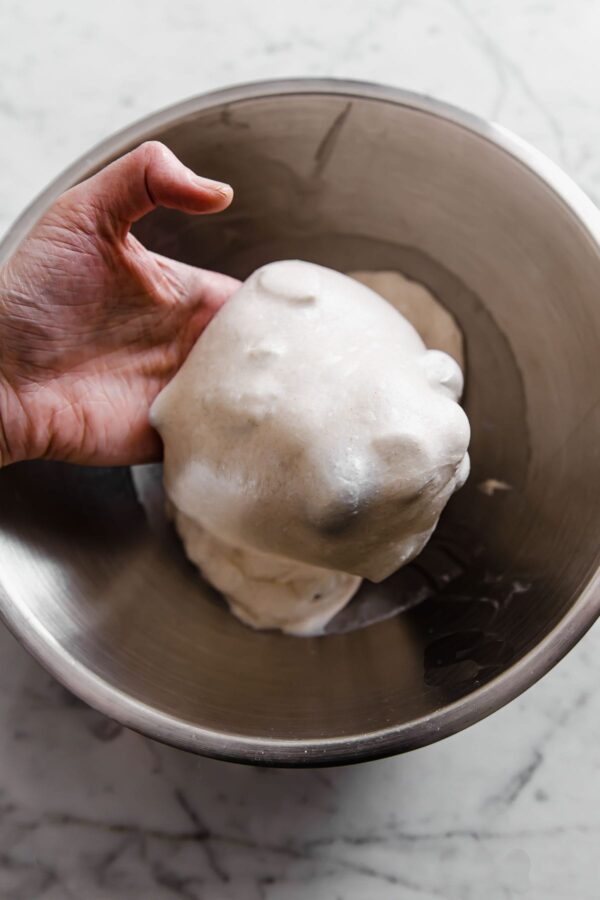
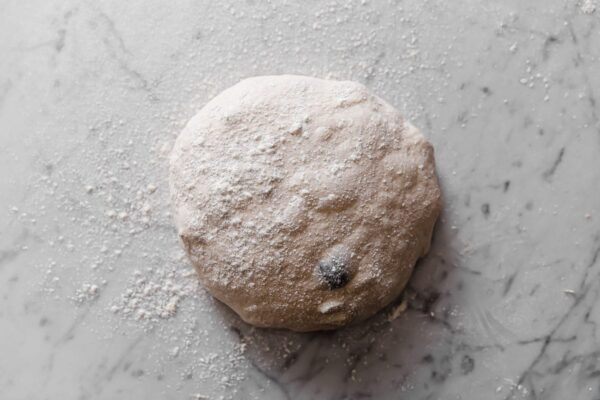
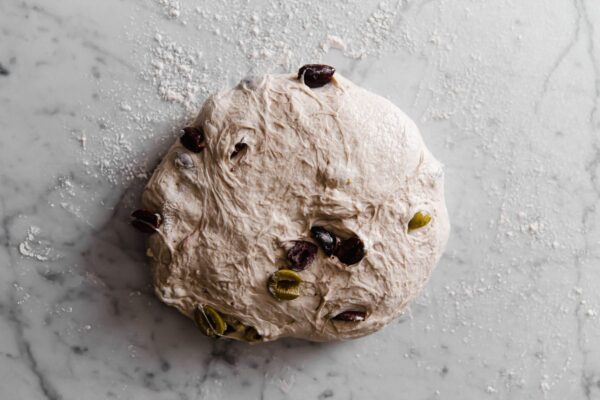
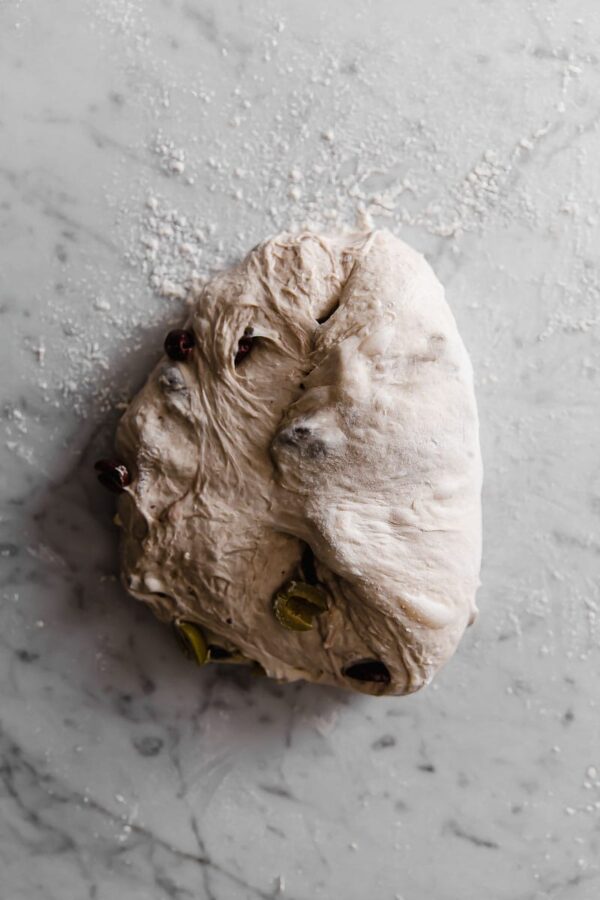
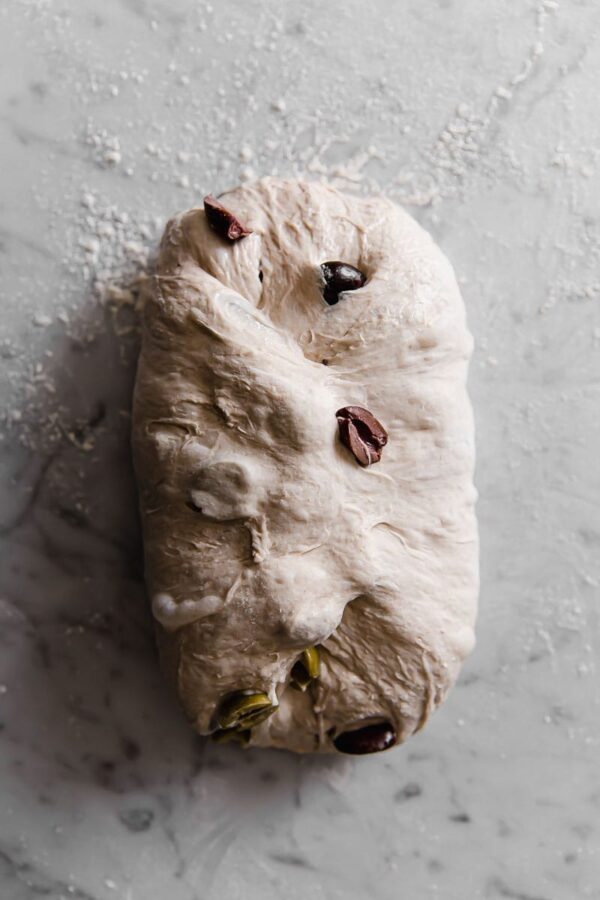

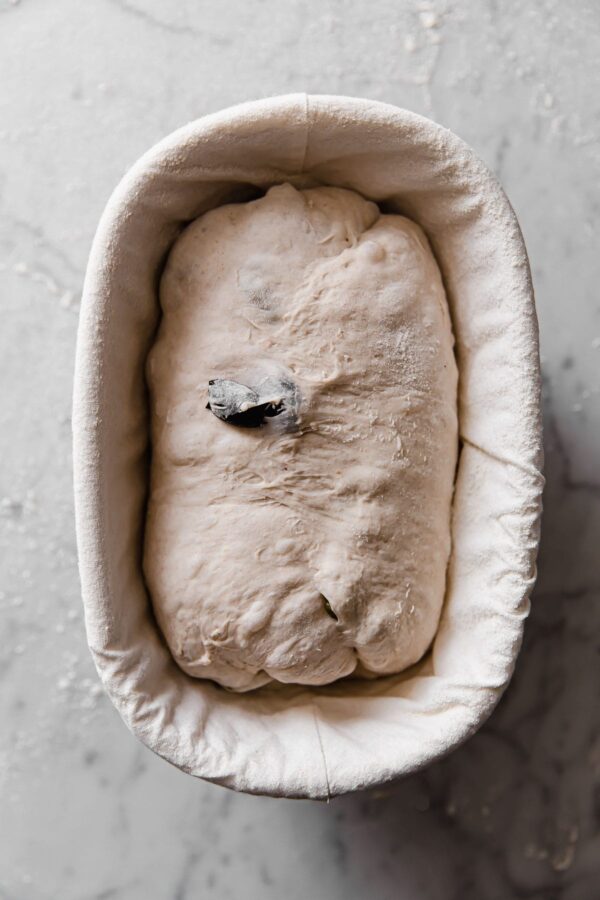
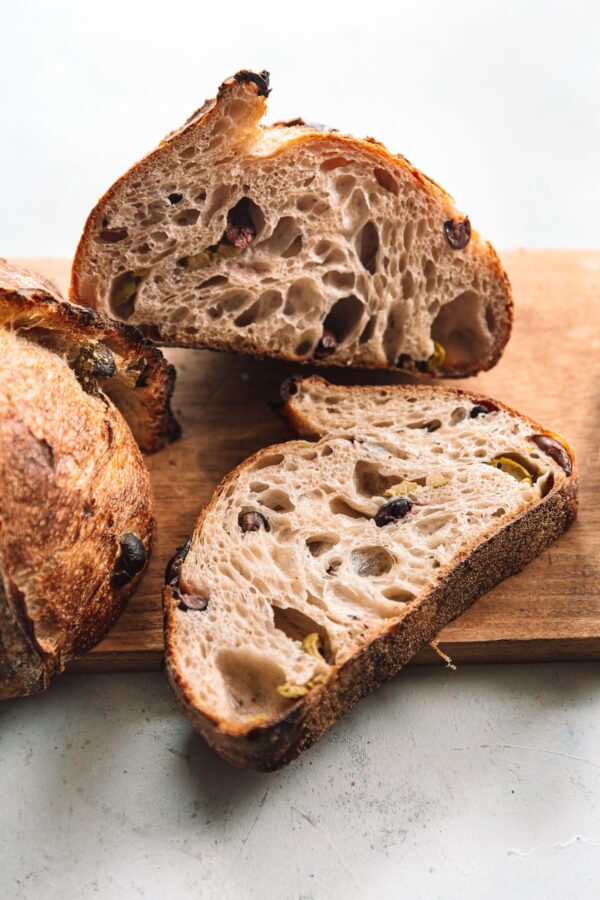
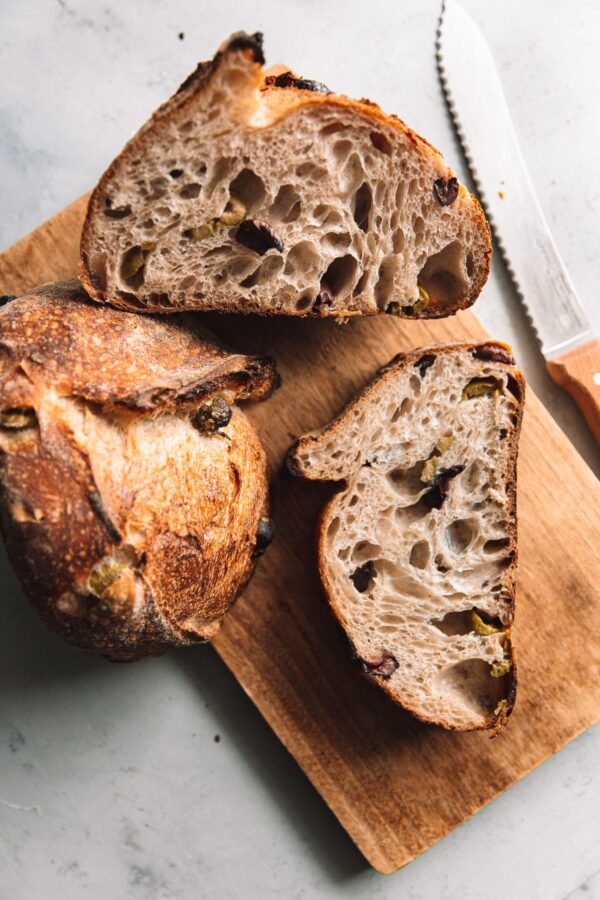
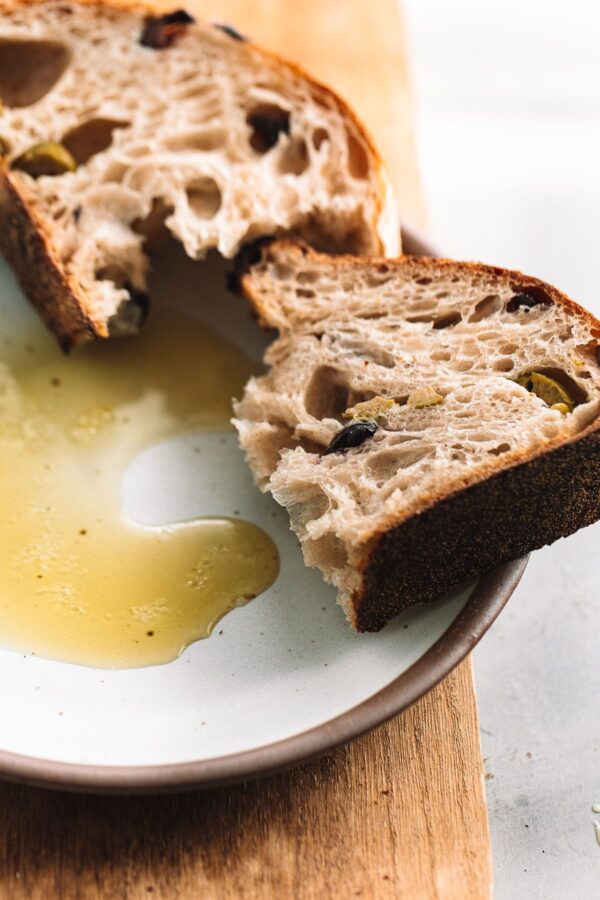
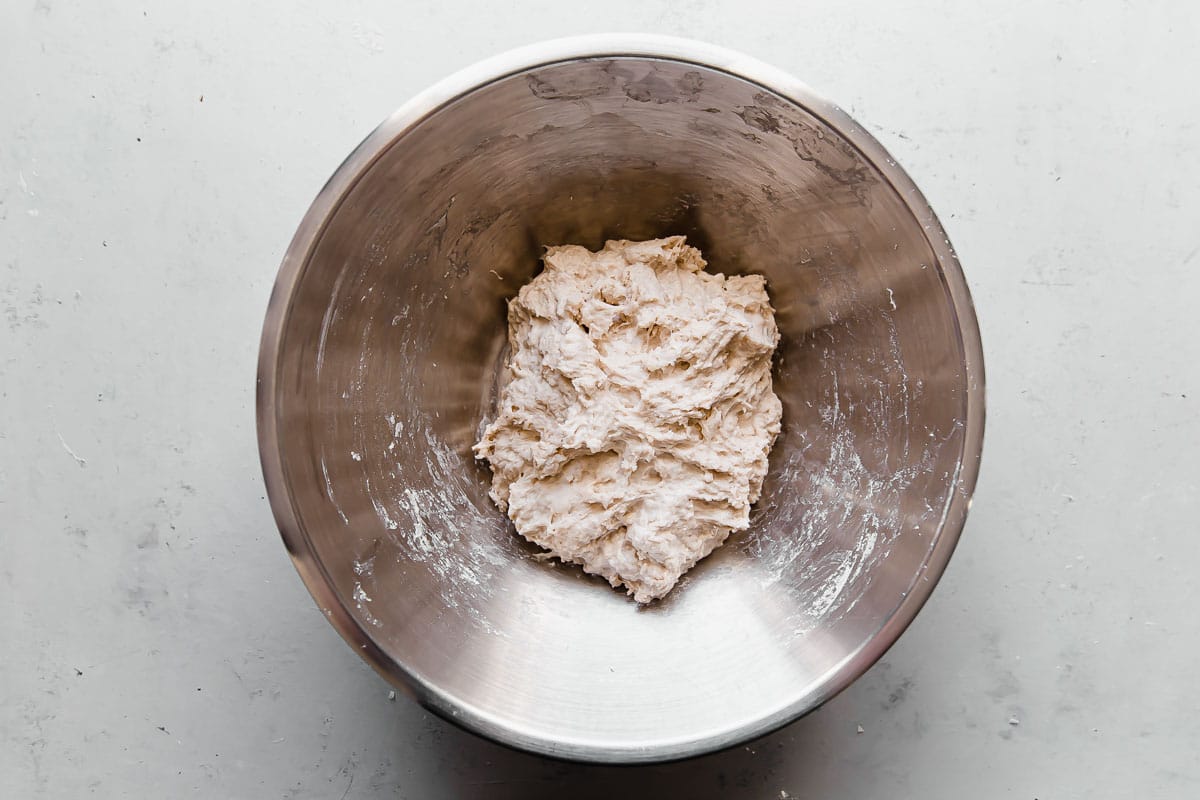
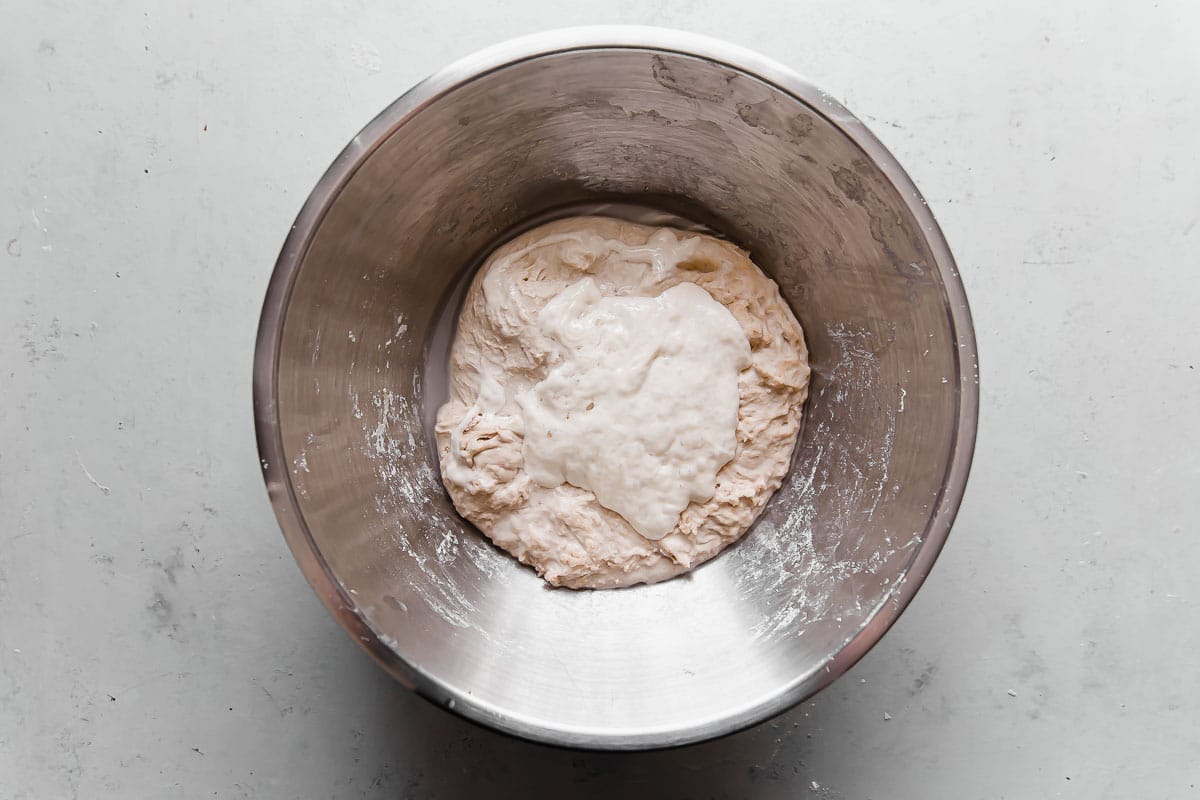
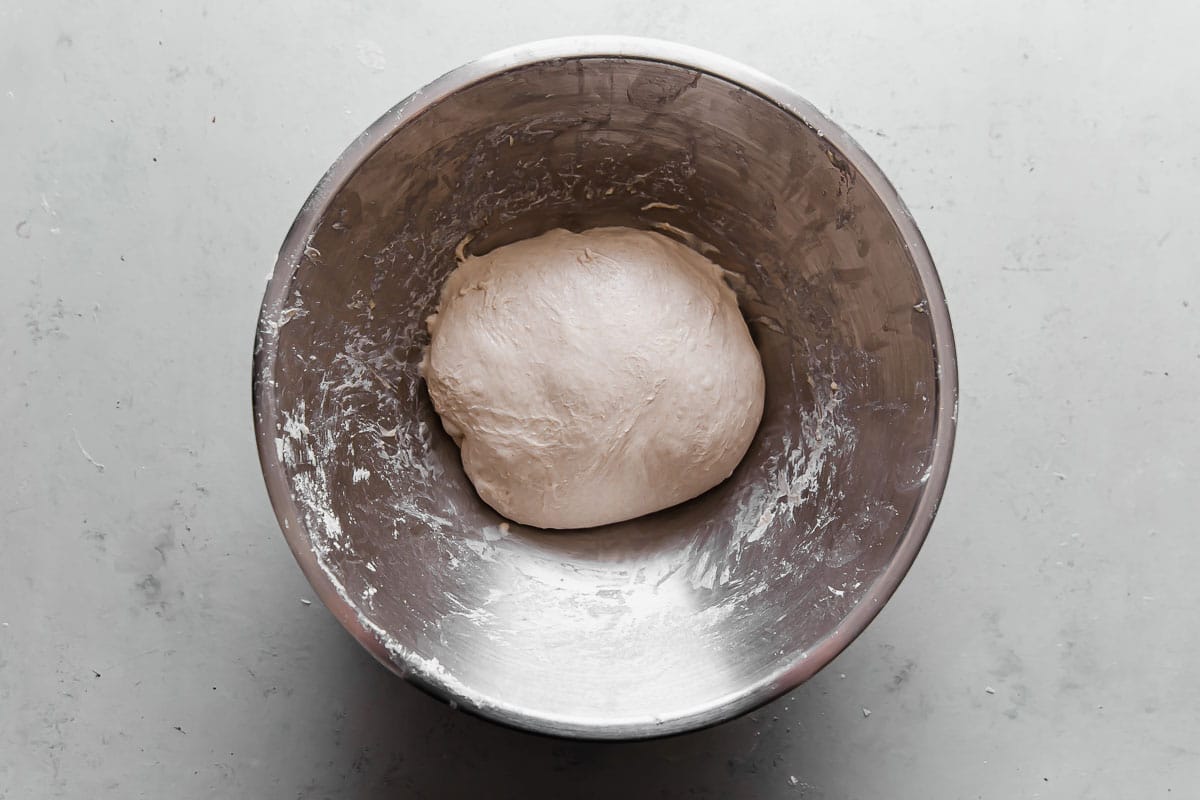
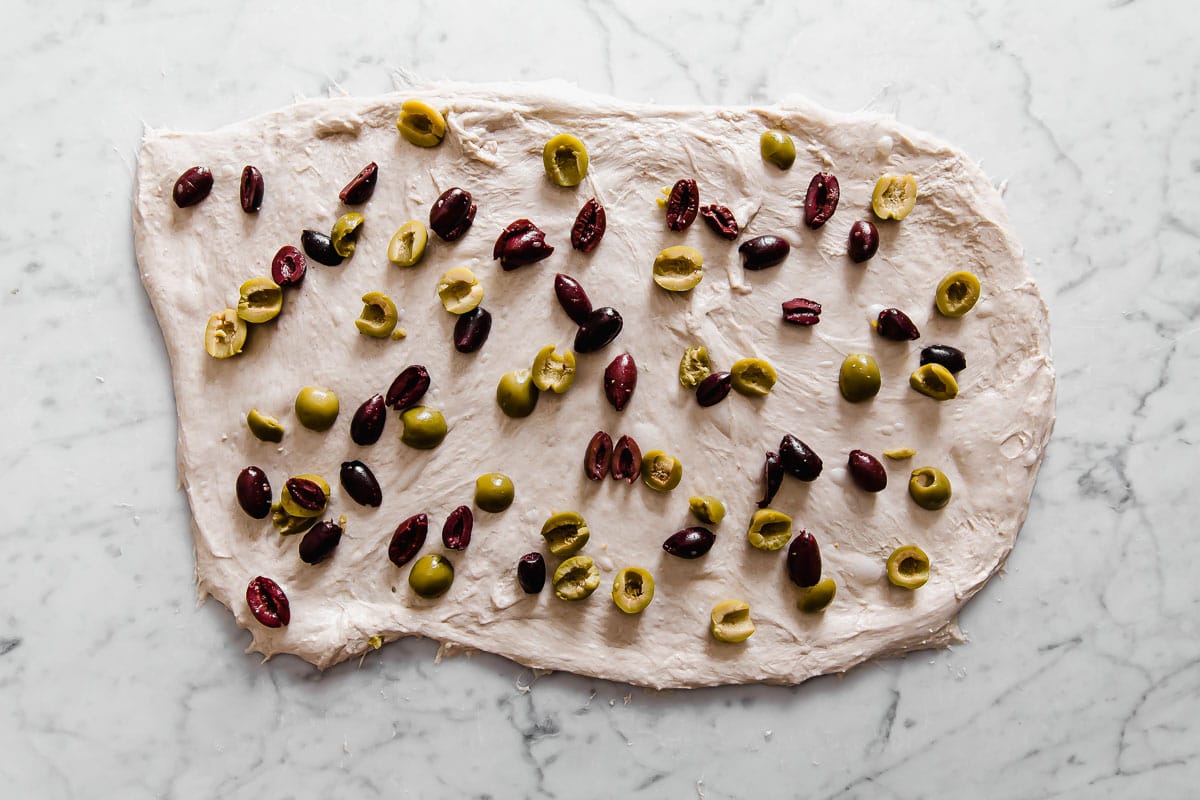
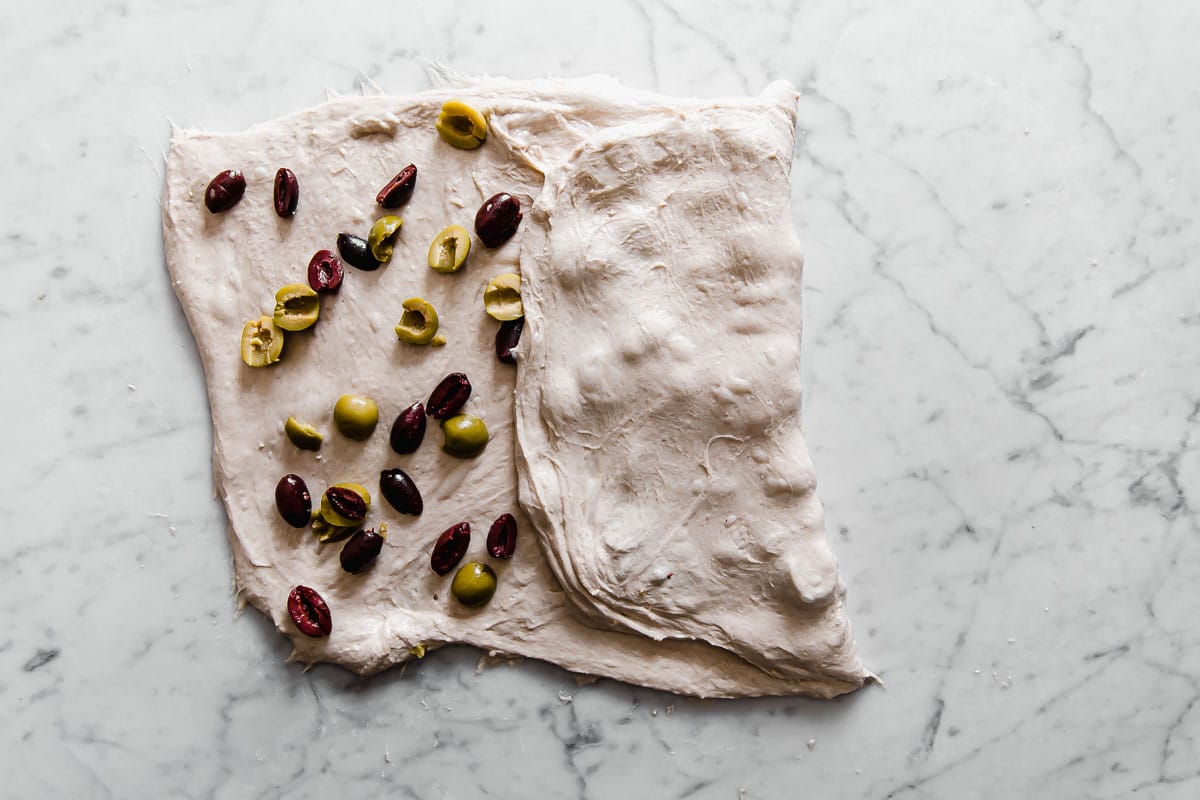
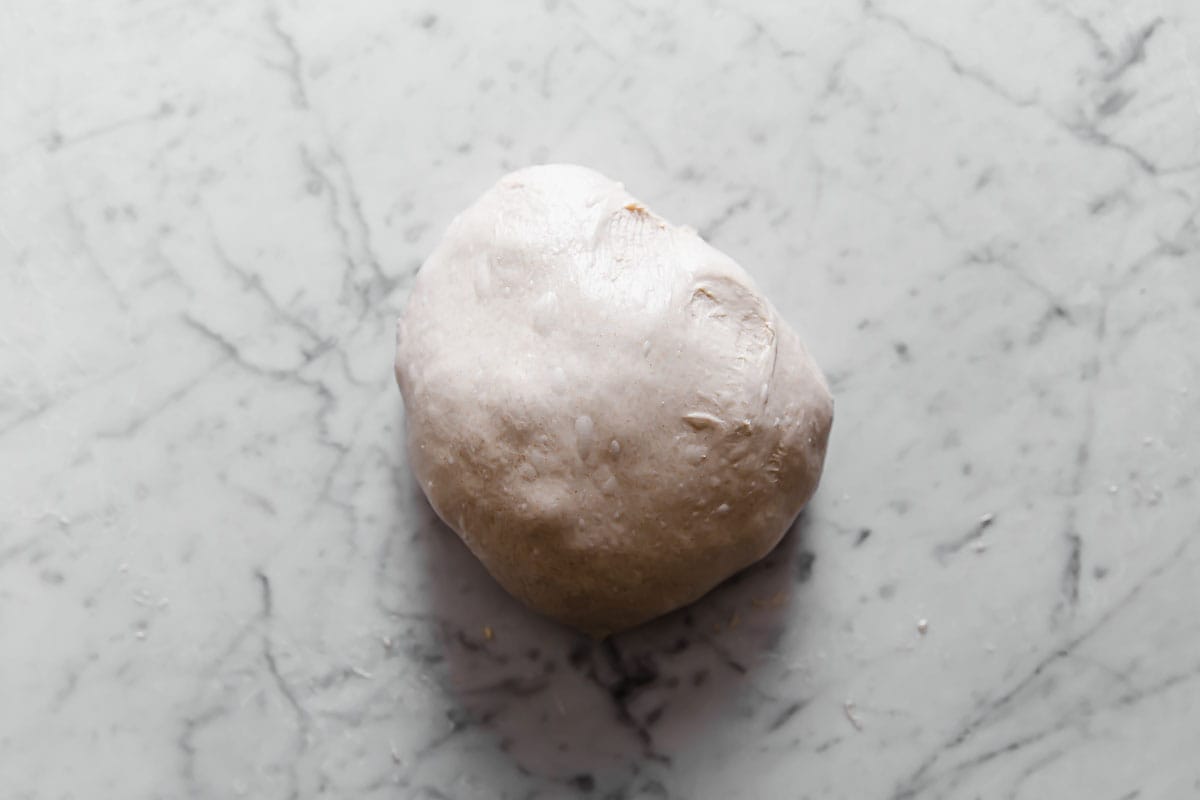
9 Comments on “Kalamata and Castelvetrano Olive Sourdough”
Could I use this recipe & instead of adding olives, add something else like dried fruit, cheese, etc.?
Definitely! Same lamination technique! Hope it goes well 🙂
I would love to try adding some olive oil to this recipe. Could you suggest how to do that and how that would change the amounts in the recipe?
Thank you
Hi Michael! This recipe really doesn’t need that and I can’t really advise how you would go about doing this, as it hasn’t been tested. I would go more the route of focaccia if you’re looking for that type of texture and taste!
The best sourdough I’ve made yet! Looks like it belongs in a high end bakery (and tastes like it, too, IMO). Thank you for the detailed instructions and delicious recipe! I have 1/3 loaf left and am making another tomorrow:)
I just made this and it’s absolutely amazing! This is the best bread I’ve ever made. Thank for the videos of how to do the various folds and shaping!
Hello, I am having an issue that once I put the olives in, when I come to the coil folds, the top of the dough tears and then the olives sort of spit themselves out and it makes it nearly impossible to fold! Any suggestions of what I’m doing wrong/how to recover once it’s happened? Thanks!
Hi Anna! It sounds like if the dough is tearing and the olives are spilling out, that your dough might be strong enough to just skip the last coil folds? I mention that in the recipe. If you don’t think the dough is strong enough to skip those last coil folds, perhaps reduce the water slightly.
I’ve had a few olives here and there sort of break the surface, but if it’s all of them, it sounds like this would help. If the dough is too strong, it’s hard to recover at that point without overworking the dough in that stage of the process. Alternatively, you could add the olives earlier during mixing – without lamination – and that’s another option, although tends to be my preferred method and helps with strength building.
thank you, I allow myself to eat these kinds of carbs rarely especially sourdough but really want them to be good when I do and that to me means making from scratch so I was so happy to see this post, from today even, and the walk through and love both kinds of olives, great weekend project!